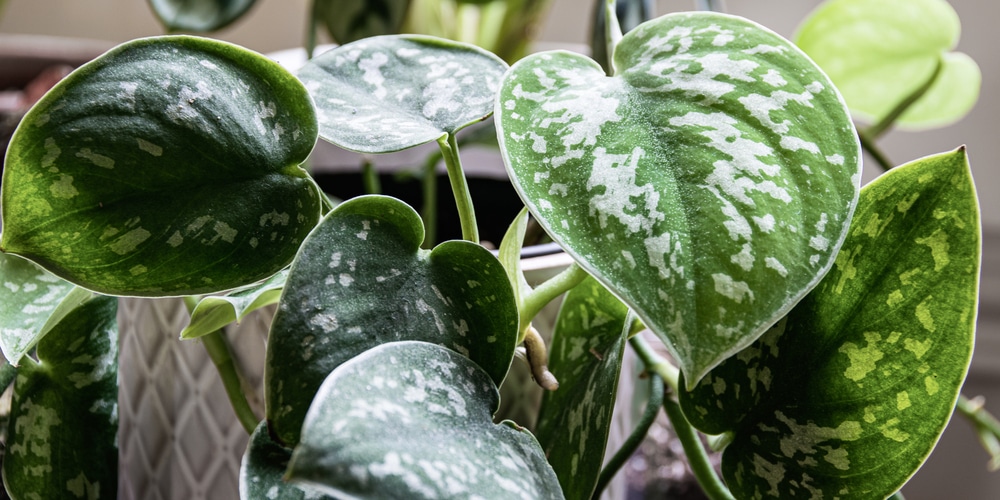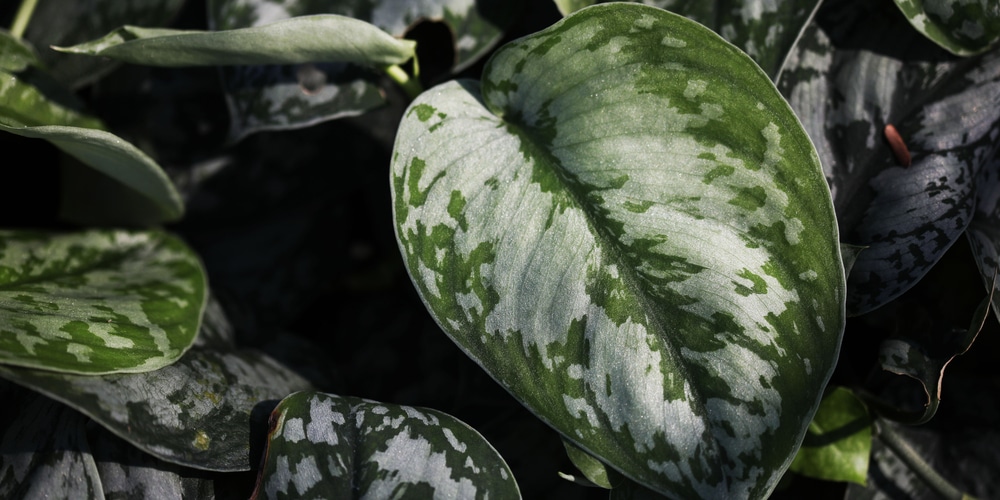Silver Satin Pothos (Scindapsus Pictus) is one of the most beautiful types of Pothos. The dark green leaves are marked with irregular silver striations on the top, giving them a shimmering effect against the light.
An easy-care for foliage plant, Silver Satin Pothos can be used as a hanging basket, tabletop plant, or planted in a container on a patio. It can also be planted outdoors in warmer climates in USDA zones 10 to 12. Let’s look at how to grow and care for a Silver Satin Pothos.
What is a Silver Satin Pothos?
Silver Satin Pothos is an evergreen vining plant that grows in tropical climates. It’s part of the Araceae family and originates from Asia. These plants are commonly found growing throughout China, India, the pacific islands, and Australia.
It has thick, arrowhead or heart-shaped leaves that are dark green above with silver underneath (very similar to Silvery Ann Pothos or Silver Splash). The stems are woody and climbing, but the plant does not twine like other plants. Silver Satin Pothos botanical name is (Scindapsus Pictus).
In early spring, it will produce new growth that can reach a length of 6 ft. if provided adequate support for climbing. The leaves of the plant are oval to heart-shaped with dark green centers and silver splotches underneath. The vines grow rapidly and can be trained to climb if provided the proper support, but do not twine like other plants.
Like all pothos plants, the silver satin pothos is considered a skin irritant. It can cause dermatitis in sensitive individuals and is also toxic if ingested by humans and animals. If ingested or exposed to skin, flush with water and call a physician immediately. It would also be best to keep this plant out of the reach of pets and small children.
How to Care for a Silver Satin Pothos
Outdoor plants should be grown in the bright indirect sun with moist soil and adequate drainage. They may tolerate some shade, but growth is slower. The vines grow rapidly and produce lush foliage when provided adequate water and fertilizer during the growing season from spring to fall. Here are some tips to help you grow a thriving Silver Satin Pothos:
Sunlight needs
Silver Satin Pothos will grow in low light conditions but thrives in areas of bright indirect light. These plants do best when they get at least six hours of sunlight a day. If moved from indoors to outside, provide bright light for the best leaf color and growth. Be careful not to leave your plant in the full sun during the hottest part of the day, or the foliage will scorch.
Watering Requirements
Keep the soil moist, but avoid overwatering as this causes root rot. Reduce watering during the winter months. If grown as a houseplant, care should be taken to avoid getting water on the leaves, as this can cause leaf spots or fungal infections. It’s a wise idea to test the soil with your finger before watering. Allow the soil to dry slightly between watering.
Humidity
Indoor humidity levels should be kept at around 50%. You can group tropical plants together and mist the plant’s foliage frequently to provide adequate moisture. Be careful not to drench the leaves, or you may encourage mold to grow. You may also like to use a water and pebble tray to improve humidity. Place this under your plant; as the water evaporates, it will provide your plant with moisture.
Temperature
Silver Satin Pothos can’t tolerate very low temperatures and should only be grown year-round in warmer climates in USDA zone 10 to 12. Don’t leave your plant outside if frost is expected or the temperature is likely to fall below 55F. If left in cold drafts, your plant will also likely suffer, and leaves will become tattered and damaged. Mildewed foliage can occurs with warm temperatures and high moisture, so make an effort to get temperature and humidity levels right for your plant.
Fertilization
Feed your pothos plant monthly with a houseplant fertilizer that is diluted. It’s recommended to either use a fertilizer explicitly formulated for tropical plants or mix 1/2 of recommended strength of standard houseplant fertilizer.
Soil
Scindapsus Pictus likes loose soil and well-draining with a pH range of between 6.1 and 6.5. Pothos are relatively forgiving and can grow in soil that’s outwith this range as they are adaptable. You can add some peat moss or perlite to the earth to improve texture. It’s also a good idea to add a layer of gravel or stones to the bottom of the pot, as this can help with drainage.
Pests and Diseases
Common pests include mealybugs, spider mites, whiteflies, scale insects, and thrips. Leaves may also be affected by fungal infections such as powdery mildew or rust. You can treat the plant with an appropriate pesticide and provide good garden hygiene to minimize pest problems.
Propagation
You can propagate a mature silver satin pothos via stem cuttings or division in spring or fall. Place the cutting in water or moist soil where roots will grow. If you’re using soil, you can speed up the process by dipping the end of the cutting in rooting hormone.
Plants are typically grown from stem cuttings but can also be propagated with root division during regular garden maintenance or in early spring. If the plant becomes pot bound or does not produce new growth, it can be divided by carefully removing the top growth of the plant and separating it into new plants. New plants should have at least three leaves, but larger divisions should have four or more. The best time to divide plants is in early spring, when the plant begins to produce new growth.
Conclusion
Silver Satin Pothos (Scindapsus Pictus) is a great indoor or outdoor plant that’s a perennial and can also be grown as an annual. These plants have beautiful leaves and are a popular choice for homes and offices worldwide. Silver satin pothos are relatively easy to care for as long as you get the basics right. Place your plant in bright indirect sunlight, water regularly, but let the soil dry out between waterings and fertilize your plant once a month with diluted fertilizer. You can also mist the plant’s leaves occasionally to increase humidity.

